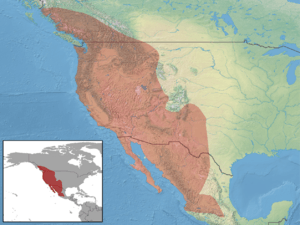Yuma myotis facts for kids
Quick facts for kids Yuma myotis |
|
|---|---|
 |
|
| Conservation status | |
| Scientific classification | |
| Genus: |
Myotis
|
| Species: |
yumanensis
|
 |
|
The Yuma myotis (Myotis yumanensis) is a small bat that lives in western North America. These bats are also known as vesper bats. They are often found near water, like lakes and rivers.
Contents
What Does the Yuma Myotis Look Like?
The Yuma myotis is a fairly small bat. Its body is about 3.9 to 4.8 centimeters (about 1.5 to 1.9 inches) long. Its wings can spread out to about 24 centimeters (about 9.4 inches). This bat usually weighs around 6 grams, which is very light!
Their fur can be different colors. Some are dark brown, while others are pale tan or even grayish. The fur is short and not shiny. The fur on their belly is much lighter, sometimes even white.
The Yuma myotis has a tail that is about 2.7 to 4.0 centimeters (about 1.1 to 1.6 inches) long. Only the very tip of the tail sticks out past the edge of the wing membrane. Their feet are big and wide, and their ears are a medium size. They have a slim, straight part inside their ear called a tragus. Their head has a short, wide nose and a round skull.
It looks a lot like the little brown bat. It can be hard to tell them apart without looking at many small details.
Where Do Yuma Myotis Bats Live?
The Yuma myotis bat lives all over western North America. They were first found near Fort Yuma. You can find them in many different places, from dry, thorny areas to forests with pine trees. However, they always live close to water, like lakes or ponds.
When they are not near water, thousands of Yuma myotis bats can be found resting. They sleep in caves, attics, buildings, old mines, and under bridges. We do not know much about where these bats travel. But some have been seen in Texas during the winter.
There are six different types, or subspecies, of the Yuma myotis bat:
- M. y. iambi - Lives only in central Baja California Sur in Mexico.
- M. y. lutosus - Found from Sinaloa to the State of Mexico.
- M. y. oxalis - Lives only in central California.
- M. y. saturatus - Found in British Columbia, western Washington, Oregon, and most of California.
- M. y. sociabilis - Lives in eastern Washington and Oregon, Idaho, western Montana, and northeastern California.
- M. y. yumanensis - Found in southeastern California, southern Nevada, Utah, Colorado, and across to western Texas and northwestern Mexico.
How Do Yuma Myotis Bats Live?
Yuma myotis bats are active at night. They hunt for insects above slow-moving water or in plants near the water's edge. They are very good at flying and can fly up to 9 miles per hour. They start hunting when the sun goes down and finish a few hours later.
They eat beetles and soft-bodied insects. They are not picky eaters and will eat whatever insects are most common in their area. For example, they mostly eat moths in Texas. But in Oregon, they mainly eat flies. Like most bats, the Yuma myotis uses echolocation to find insects. They send out high-pitched sounds. Then they listen for the echoes to find their prey. They catch insects with their mouths or use their tail membranes like a net for bigger insects.
These bats naturally roost, or rest, in caves, rock cracks, and hollow trees. But today, they are more often found in buildings or other structures near water. In good spots, a group of these bats can have as many as 10,000 members! They are not very active in winter. They spend some time in a sleep-like state called torpor. They probably do not travel very far for winter.
Reproduction and Life Cycle
Yuma myotis bats usually have a mating system where both males and females mate with several partners. Both males and females are ready to have babies when they are about 1 year old. They usually have only one baby at a time.
Mating happens in the fall. But the female bat holds onto the male's sperm for several months. So, the egg is not fertilized right away. Baby bats are born between late May and late June. They weigh about 1.4 grams (about 0.05 ounces) when they are born. At first, they cannot see and have no fur. Their eyes open around the fifth day. By day nine, they have a full coat of fur.
Conservation of the Yuma Myotis
In May 2017, a serious fungal disease called white-nose syndrome was found in this bat species for the first time. This happened in Washington state. This discovery meant that eight different bat species were now known to be affected by this disease.
See also
 In Spanish: Myotis yumanensis para niños
In Spanish: Myotis yumanensis para niños


